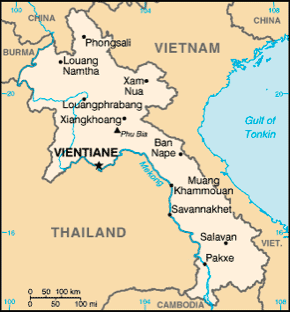Laos
Opportunity For All works with Room to Read to construct schools in Laos. Our first school was built in 2009 with four more planned with a total of 10 schools built to date. In addition, 6 matching donors have also built schools in Laos.
The only landlocked country in Southeast Asia, Laos sits between the Mekong River and Thailand on the west and Vietnam on the east. In 1975, the Pathet Lao (Nation Lao) ended six centuries of monarchical rule when they triumphed in the revolution that established the Lao People's Democratic Republic.
In 1986, the Communist government began to allow privatization, which is slowly leading to economic development. Although poverty has been reduced in the past 10 years, still more than three-quarters of Lao people work in bleak manual labor, existing on less than US$2 per day. More recently, the government has been pursuing economic reform, mostly through attracting foreign investors, and political reform, but with limited progress. Rural areas still have no electricity or potable water, and none of the basic facilities of developed societies. Subsistence farming that employs 80% of the population. Since the revolution, years of isolation and economic deprivation have also hindered the Communist state. Today it is one of the poorest and least developed countries in the world. Children suffer the most in such deprivation.
Historically, only one ethnic group, the Lao Loum, relied on formal education. Consequently, most other groups had no written language, with education taking place in Buddhist temples and catering exclusively to male students. During the French occupation, a secondary education system was established with French as the language of instruction—producing a small group of elite, well-educated Laotians. Later on in the 1950’s the Pathet Lao began to provide instruction in the Lao language. A government-led effort simplified the language in an effort to render it more accessible to all Lao people.
Today literacy in Laos is on the rise, although often short-lived due to the scarcity of available reading material. Insufficient instruction time can also be a problem, as many teachers are forced to seek supplementary income outside of school that limits their availability. Insufficient classrooms, unavailability of textbooks, limited teacher training and lack of libraries are also major roadblocks to delivering quality primary education.
While primary and secondary education are free for both boys and girls, pressure to do farm work and contribute to the family’s income have left female literacy rates lagging 17% behind their male counterparts.
Room to Read's Laos team works in partnership with the Lao government and key NGOs to address the lack of educational infrastructure in Laos. The Room to Read Laos team are locals -– they speak the language, know the customs and laws, and understand the issues surrounding the implementation of our various programs.
Room to Read has built 225 schools in Laos since 2009.
The only landlocked country in Southeast Asia, Laos sits between the Mekong River and Thailand on the west and Vietnam on the east. In 1975, the Pathet Lao (Nation Lao) ended six centuries of monarchical rule when they triumphed in the revolution that established the Lao People's Democratic Republic.
In 1986, the Communist government began to allow privatization, which is slowly leading to economic development. Although poverty has been reduced in the past 10 years, still more than three-quarters of Lao people work in bleak manual labor, existing on less than US$2 per day. More recently, the government has been pursuing economic reform, mostly through attracting foreign investors, and political reform, but with limited progress. Rural areas still have no electricity or potable water, and none of the basic facilities of developed societies. Subsistence farming that employs 80% of the population. Since the revolution, years of isolation and economic deprivation have also hindered the Communist state. Today it is one of the poorest and least developed countries in the world. Children suffer the most in such deprivation.
Historically, only one ethnic group, the Lao Loum, relied on formal education. Consequently, most other groups had no written language, with education taking place in Buddhist temples and catering exclusively to male students. During the French occupation, a secondary education system was established with French as the language of instruction—producing a small group of elite, well-educated Laotians. Later on in the 1950’s the Pathet Lao began to provide instruction in the Lao language. A government-led effort simplified the language in an effort to render it more accessible to all Lao people.
Today literacy in Laos is on the rise, although often short-lived due to the scarcity of available reading material. Insufficient instruction time can also be a problem, as many teachers are forced to seek supplementary income outside of school that limits their availability. Insufficient classrooms, unavailability of textbooks, limited teacher training and lack of libraries are also major roadblocks to delivering quality primary education.
While primary and secondary education are free for both boys and girls, pressure to do farm work and contribute to the family’s income have left female literacy rates lagging 17% behind their male counterparts.
Room to Read's Laos team works in partnership with the Lao government and key NGOs to address the lack of educational infrastructure in Laos. The Room to Read Laos team are locals -– they speak the language, know the customs and laws, and understand the issues surrounding the implementation of our various programs.
Room to Read has built 225 schools in Laos since 2009.


For general information about Laos, please look at the following:
• Wikipedia, Laos
• U.S. Department of State, Laos
• Unicef, Laos
• CIA Factbook, Laos